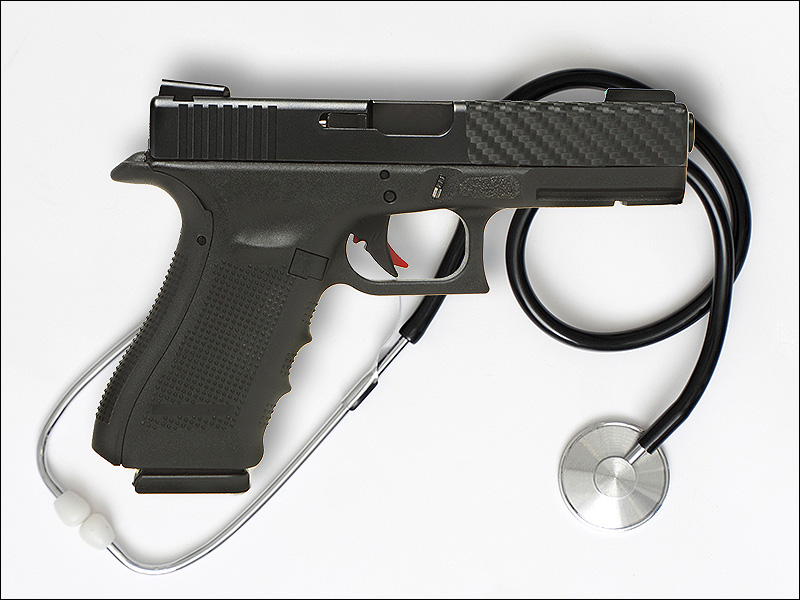The antagonism of medical leaders has infected too many physicians with disregard for the Second Amendment and the value of firearms. More than anything, DRGO’s purpose is to correct that. But addressing these prejudices, once established, is an uphill battle.
Just as more, better speech is the best response to hateful speech, education and positive experience is the antidote to the toxic attitudes of hoplophobic academics. But when you aren’t inside the ivy-covered walls, it’s a big order to match their impact on impressionable minds.
Students go to medical school eager to learn whatever they are taught on their way to becoming part of the medical fellowship. That’s why the best time and place to tell the whole truth is while they are in training. And it’s a rare opportunity.
We were delighted to learn that one of our own, Dr. John Wipfler (who wrote Keeping Your Family Safe: The Responsibilities of Gun Ownership with our founder, Dr. Timothy Wheeler) is accomplishing that.
In Dr. Wipfler’s words:
“I personally do teach 40 or 50 med students (2nd / 3rd year) from the Univ[ersity] of Illinois College of Medicine [UICM] about firearms safety, marksmanship, and tactical medicine each year, at my house, using Airsoft CO2 pistols . . . [A]lso every student (who chooses to, and most do) gets to shoot a semi-auto 12 gauge a few times. Probably 2/3 of the students have never shot a gun before. They all leave with important information, a smile, and hopefully have a more positive view about the topic.”
Neither Dr. Wipfler nor the rest of DRGO’s team have heard of this happening anywhere else. With colleagues, he mentors students belonging to the school’s Emergency Medicine Interest Group (EMIG). He volunteers his farm (well-equipped as a live action training facility) each fall for a 6 hour weekend experience of learning about and shooting guns. They teach emergency trauma first-aid at the same time, as well as the philosophy of rightful self-defense, its tactics and how to respond when encountering people who carry. Each participant gets a personal Individual First Aid Kit to take home.
After dinner, a highlight for hungry students everywhere, the excitement peaks further. They arm up with airsoft guns/weapons, and get to try clearing a house. Then they split into two teams for a hostage rescue scenario. They learn that these jobs aren’t as smooth as typically depicted. They also get more first aid practice as they treat the wounds they would have incurred as amateur SWAT team members.
Per Dr. Wipfler: “Highlight of the evening is blasting a gallon of gasoline with a 12 gauge from 15 feet, at night, with resultant fireball and 12 foot diameter instant campfire.” Most are hooked now. But by the end of the evening, even those who may not continue to shoot avocationally have learned that guns are tools in our hands, not scary weapons of mass destruction.
The whole point is it is to educate the students on gun safety as well as have some fun with it. Airsoft is a perfect way to do this and in the past, some students have even taken it up as a hobby after taking part in the hostage rescue scenario. If you’re interested in finding out more about Airsoft then take a look at this paintballfreedom.com article to find out more. A lot of students find that their opinions on guns are changed after the course so it’s nice to see that it’s working.
Dr. Wipfler says that the UICM dean has thanked him often, so there is official recognition of the value of familiarity with guns and gun safety. He was apparently able to get this going as a result of precepting the EMIG, and then offering them this extra added attraction for whoever was interested. That may have been a more successful approach than bluntly proposing a firearms addition to their required course of study (not that that wouldn’t be good for everyone). “Most med school curriculum committees are highly jealous and guard each ‘second’ of teaching time given to med students, and it’s hard to add on new material.”
Neither Dr. Wipfler nor I have heard of other medical schools where there is any firearm education given. If there are, it would be great to hear about other ways in which they were introduced and to collaborate in efforts to introduce the subject elsewhere.
While almost any age is a good one to teach gun safety and beginning shooting, medical students seem an ideal crowd. Their biases haven’t yet solidified, and they are still active learners. They have proven themselves to be unusually responsible. And they are the future of our profession.
The Jesuit maxim about influencing development applies to youth in general: “Give me the boy . . . and I will give you the man.” That’s part of the reason so many doctors become anti-gun-the wrong people have them. We need to get ‘em while they’re young! Maybe let them use airsoft guns from www.onlybbguns.co.uk to bring ’em onto our side.

– DRGO Editor Robert B. Young, MD is a psychiatrist practicing in Pittsford, NY, an associate clinical professor at the University of Rochester School of Medicine, and a Distinguished Life Fellow of the American Psychiatric Association.

